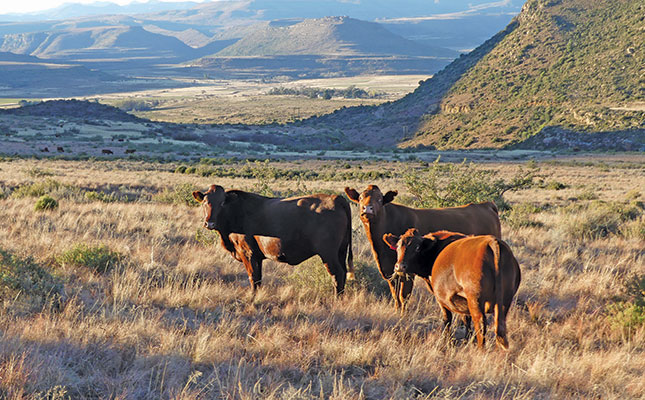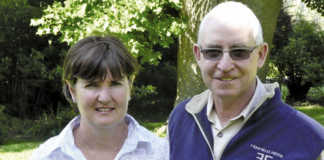
Photo: Mike Burgess
To Johan Greyling and his son, Michael-John, cattle farming should focus on low-cost, sustainable production of the maximum marketable kilograms of beef per hectare of natural grazing.
Their Arwin Farms Bonsmara Stud is a product of a near four-decade-long selection process aimed at producing functionally efficient cows that raise marketable weaners off the veld.
“You don’t start a stud to sell bulls; you start a stud to improve your cows,” says Johan. “If you want to go in a certain direction, you breed them in that direction. It’s a long process but that’s what you have to do.”
Towards the Bonsmara
The Greylings’ forebears moved to the area between Dordrecht and Lady Grey in the 1840s, and settled with their span of Afrikaner oxen and small herd of breeding cows. Their Afrikaners remained pure up until the 1950s, when Johan’s father, Michiel, bought some Dairy Shorthorns to produce milk for the cheese factory based at the nearby settlement of Clanville.
By the time Johan started farming with his father in 1968, they had 80 Shorthorn x Afrikaner cows and a vibrant sheep enterprise. Johan put Hereford bulls to the herd, and although the initial offspring, fuelled by hybrid vigour, were excellent, it became clear that the new type could not cope well with the mountains in the area.
This lack of functional efficiency proved to be a fatal flaw, as an economic analysis of their productivity exposed their redundancy.
“The cattle weren’t paying,” Johan recalls. “We had two options: fix the problem or get rid of the cattle.”
The Greylings opted to fix it by turning to the popular Bonsmara breed, which by this stage was excelling in performance testing.
Johan was also convinced that a medium-framed version of this indigenous synthetic breed would be able to produce efficiently on the veld in their region. In the late 1970s, therefore, he bought two Bonsmara bulls from the Van der Merwe family near Barkly East, and put them to the family’s crossbred herd.
Well-satisfied with the Bonsmara-type progeny, Johan jumped at an unexpected opportunity to source Bonsmara genetics from his neighbour, Faantjie Greyling.
Faantjie had acquired a Bonsmara bull from the Queenstown Bull Sale and 18 cows from the Knotts of Grahamstown and the Hartleys of Dordrecht, but when confronted with the paperwork demanded by the Bonsmara Cattle Breeders’ Society, thought it prudent to offer the herd to Johan instead.
Johan managed to leverage a Land Bank loan and purchased the cattle. These, with 97 Bonsmara-type animals passed CattleGreyling family herd, would form the foundation of the herd that would go on to become the Arwin Farms Bonsmara Stud, registered in 1982.
Overstocking
By the mid-1990s, a drought uncovered a flaw in Johan’s beef production system.
“I was overstocked, and lost so much money that I only recovered in 2001 after wearing my knees out in front of the bank manager’s desk,” he recalls. “Look after your veld! It’s your most valuable asset.”
Johan managed to pull through, but, drawing on this experience, employed the more accurate Meissner stocking rate from then on. Rather than using the broad large stock unit construct, this narrows animals down into categories of small-, medium- and large-framed.
“Getting the right balance of animals to our grass was learnt the hard way,” he says.
After Michael-John returned to farm in 1996, following a practical year at Glen Agricultural College near Bloemfontein, the father-son team realised that their Bonsmaras had become too large to utilise the rugged terrain effectively; this was repeating the problem that had occurred in the 1970s with the Hereford x Shorthorn x Afrikaner crosses.
It is an easy error to commit when selecting on indices, says Johan, as the norm is to select the heaviest weaners as future breeding stock, despite the dangers to functional efficiency.
“When I looked again, I was producing 240kg weaners, which seemed good, but my herd had become unproductive, as conception rates and wean ratios started dropping and the cattle weren’t walking the mountains.”
The Greylings started buying smaller-framed bulls to reduce the size of the animals, and today the stud cows and first calvers weigh on average 423kg when weaning their calves.
The cattle receive a protein lick in winter and a phosphate lick in summer, and cows receive a maintenance lick in very dry years to help them produce calves with an average birthweight of 33kg, and weaners with an average of 48% of their dams’ weight.
Fertility
In a beef operation, fertility is arguably the key economic factor. However, it is very difficult to breed fertility, with its notoriously low heritability, into a herd. Moreover, feeding females to enhance conception does not confront the core fertility dilemma, but only masks it, says Johan.
What is needed is to place selection pressure on cows by making them calve on extensive conditions. The Greylings are therefore comfortable with allowing the calving rate on the veld to be determined by climatic conditions. In dry years, their calving rate is between 76% and 80%, while in wet years it is 88% to 90%, resulting in weaners weighing between 180kg and 220kg at 205 days adjusted.
Importantly, these figures are not achieved with expensive feed. It is wrong to assume that calving percentages and weaning weights relate to how much money you make, according to Michael-John.
“What must be taken into account is how much it costs to ensure the high calving percentage and heavy weaning weight,” he says.
All stud heifers are put to spare grazing before being mated at 24 months. Mating heifers at a younger age in their extensive production system does not make long-term sense, says Johan.
“My conclusion is that female animals that grow well in their first year also develop their reproduction organs very well. For whatever reason, young females that don’t grow well will be sub-fertile for the rest of their lives.”
Although all heifers that don’t conceive are culled, Johan believes that a zero-tolerance culling approach to skipping cows often results in the removal of great dam lines. Cows are therefore allowed to skip once in their lifetime.
Phone Johan Greyling on 082 388 0597, or Michael-John Greyling on 072 453 5556.









